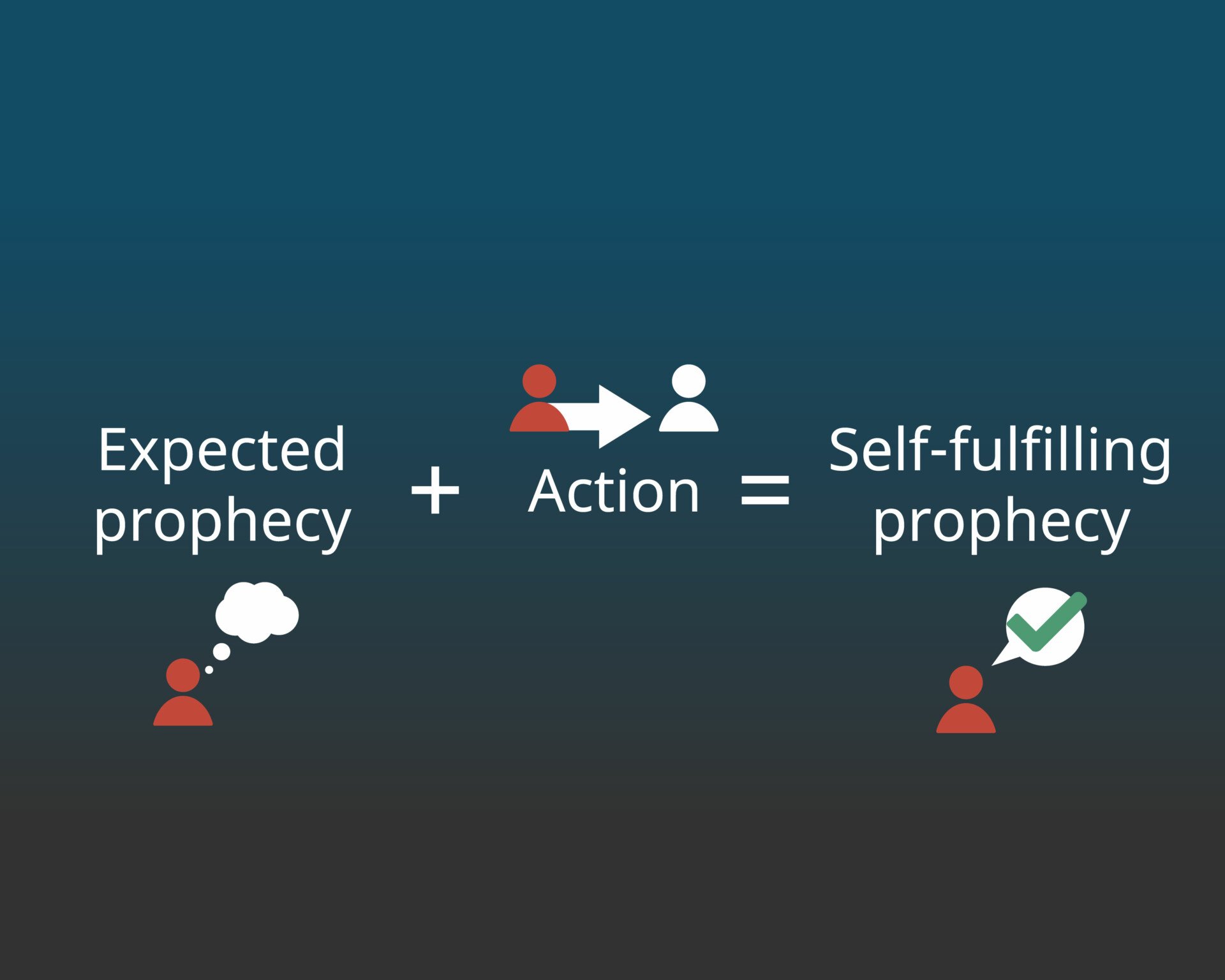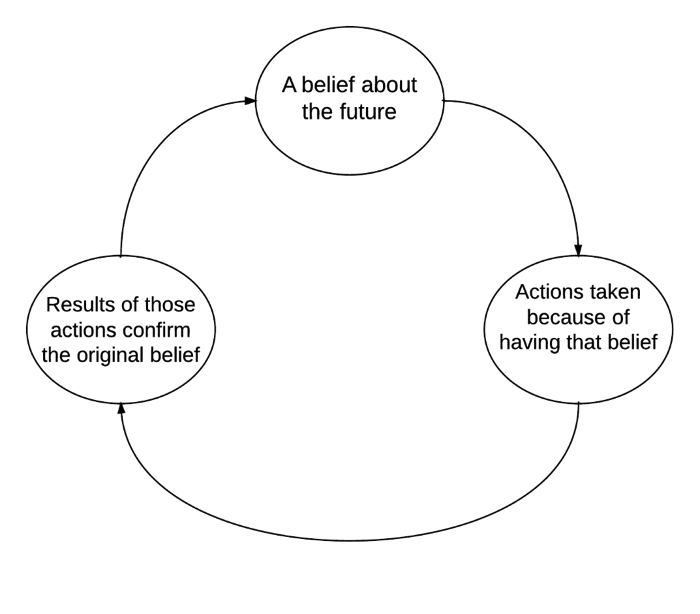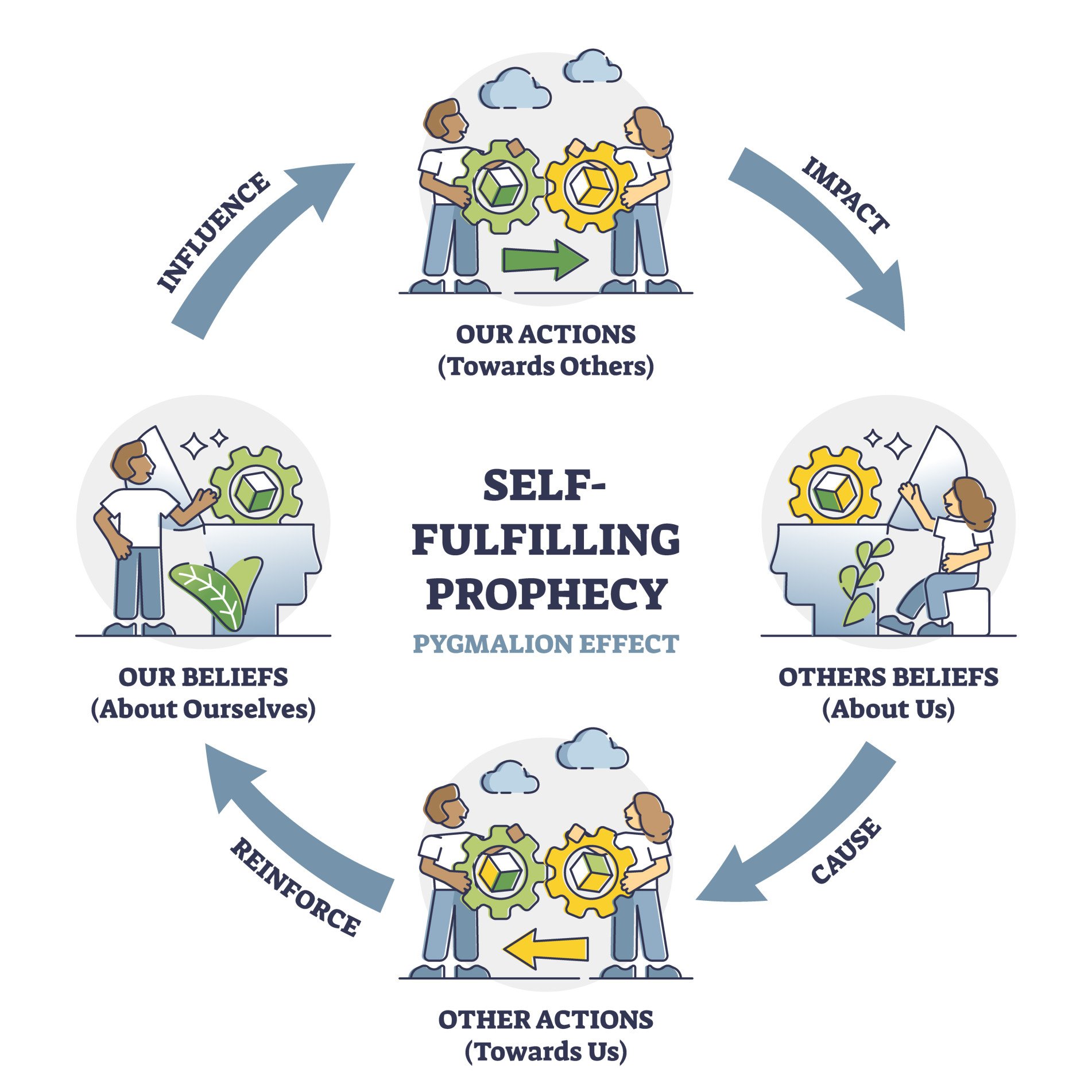On This Page:
Key Takeaways
- A self-fulfilling prophecy is a sociological term used to describe a prediction that causes itself to become true.
- Therefore, the process by which a person’s expectations about someone can lead to that someone behaving in ways that confirm the expectations.
- An example of a self-fulfilling prophecy is the placebo effect when a person experiences beneficial outcomes because
- they expect an inactive “look-alike” substance or treatment to work, even though it has no known medical effect.
- In the classroom, a self-fulfilling prophecy occurs when a teacher holds expectations for students, which through social interaction, causes the students to behave in such a manner as to confirm the originally false (but now true) expectation. For example, lower expectations for students of color and students from disadvantaged backgrounds and higher expectations for middle-class students.
- There are two types of self-fulfilling prophecies: Self-imposed prophecies occur when your own expectations influence your actions. Other-imposed prophecies occur when others’ expectations influence your behavior. All opinions you value can cause this prophecy.
- The Pygmalion effect is a type of other-imposed self-fulfilling prophecy that states the way you treat someone has a direct impact on how that person acts.
- If another person thinks something will happen, they may consciously or unconsciously make it happen through their actions or inaction.

Definition
In 1948, Robert K. Merton coined the term self-fulfilling prophecy to describe “a false definition of the situation evoking a behavior which makes the originally false conception come true” (Merton, 1968, p. 477).
In other words, a misrepresentation of reality or guessing at the truth that, in turn, causes behaviors that would end up making this hypothetical into an actual reality.
Simply put, a false reality could actually become truth due to human psychological responses to predictions, fears, and worries associated with the future.
The self-fulfilling prophecy has also been referred to as the “bootstrapped induction,” the “Barnesian performativity,” or “The Oedipus effect” (Biggs, 2011).

Self-Fulfilling Prophecy Examples
Placebo Effect
An example of a self-fulfilling prophecy is known as the placebo effect. In this example, patients are randomly split into two groups: one receiving the new treatment and one receiving a placebo treatment or “fake treatment.”
Those who are given the placebo drug have been shown to display improvements in the respective issue despite there being no active agent causing the recovery.
The beliefs that one held, in contrast to actual treatment, led to that prophecy being fulfilled.
Stereotype Threat
Stereotype threat refers to the concern that one’s actions may fulfill a negative cultural stereotype of one’s group (Steele 1997). Such concerns may, paradoxically, lead to the fulfillment of those stereotypes
Another example of a stereotype threat concerns African American intelligence and resulting college admission.
In the past, researchers believed that African Americans were less intelligent than other races due to their lower reported scores on standardized tests (Dzaferagic, 2019). This research was then used to justify the admission of a smaller percentage of African Americans to colleges and universities.
However, this discrepancy can be explained by the self-fulfilling prophecy in the form of a stereotype threat (Steele 1997).
Since other individuals’ expectations of African Americans were lower, they fulfilled their expectations.
It is thought that the negative stereotype of African Americans led them to become anxious about taking their tests which led to poorer results than they were actually capable of. This further confirmed the stereotype. We see what we want to see.
Types
There are two types of self-fulfilling prophecies: self-imposed and other-imposed (Adler, 2012). Both lead to the same result, yet they are different approaches to getting there.
Self-Imposed Prophecies
In a self-imposed prophecy, one’s own expectations are the causal factor for one’s actions. An example is illustrated through a public speaking scenario.
In this scenario, a man named John has had previous experience with failure in a public speaking setting. He is extremely nervous and believes he will fail.
Due to this, as he begins his speech, he stumbles over his words, forgets his lines, and fails to produce a coherent message. Therefore, because John believed he would fail, he did.
Other-Imposed Prophecies
An other-imposed self-fulfilling prophecy arises when others’ expectations of another individual affect the actions of that individual. A classic example is the fortune teller scenario.
Cindy, a fortune teller, tells a man named Peter that he will one day become a therapist. Because Cindy imposed this expectation on Peter, he began to believe it.
Eventually, because Cindy’s expectations affected Peter’s beliefs, he did one day become a therapist. The Oedipus example above is another example of an other-imposed self-fulling prophecy.
Other-imposed self-fulfilling prophecies are at the root of racial and gender stereotyping and discrimination. If a person has certain expectations for a person of another race, they will treat them accordingly, which might position this person in a place fitting of the stereotype they’re believed to fit under.
For example, if it is believed that women are better in certain lesser roles than men, women are more likely to fulfill this prophecy and not live up to their full potential.
The key idea in both types of self-fulfilling prophecies is that the idea of an unbacked or false notion spurs behavior that, in turn, makes a person act “as if” the idea was a reality until, eventually, these behaviors build a reality where the prophecy comes true.
The Pygmalion Effect
“When we expect certain behaviors of others, we are likely to act in ways that make the expected behavior more likely to occur.” (Rosenthal & Babad, 1985).
The term Pygmalion Effect originated from a poem by the Greek poet Ovid entitled Metamorphoses (The Pygmalion Effect, 2020).
In it, Pygmalion was a sculptor who eventually fell in love with one of his own creations. Pygmalion begged the gods to deliver him a wife similar to the sculpture he became enamored with.
As the story goes, the gods made his wish come true, and the sculpture came to life. Rosenthal and Jacobson became inspired by the story and subsequently named their findings after the sculptor.

Rosenthal and Jacobsen (1968)
A famous study on other-imposed self-fulfilling prophecies is the Pygmalion Effect. Rosenthal and Jacobsen (1968) conducted an experiment to see whether student achievement could be self-fulfilling based on the expectations of their teachers.
Rosenthal and Jacobsen gave elementary school children an IQ test and then informed their teachers which children were going to be average and which children were going to be ‘Bloomers,’ the twenty percent of students who showed “unusual potential for intellectual growth.”
They found that the teachers did not expect too much from the average children and gave all their attention to the Bloomers. The teachers created a nicer environment for the Bloomers; they gave them more time and attention, called on them for answers more often, and gave them more detailed feedback when they got something wrong.
However, unknown to the teachers, these students were selected randomly and may or may not have fulfilled that criterion.
After eight months, they came back and retested the children’s intelligence.
The results showed that Bloomers IQ scores had risen (experimental group) significantly higher than the average students (control group), even though these academic bloomers were chosen at random. The bloomers gained an average of two IQ points in verbal ability, seven points in reasoning and four points in over all IQ.
The experiment showed that teacher expectations worked as a self-fulfilling prophecy. The teachers’ expectations had altered the way the children were treated, and this had affected their abilities.
According to the Pygmalion effect, the other-imposed expectations imposed on the students by the teachers are internalized by the students and become part of their self-concept, and they act accordingly to their internal beliefs about themselves.
These results were replicated in college-aged students as well. Studies conducted in algebra classes at The Air Force Academy, engineering students, and many other universities replicated these results (Rosenthal & Rubin, 1978).
Implications
Stereotypes are often part of self-fulfilling prophecies. Claude Steele’s research (1997) on stereotype threat shows that when students worry that their own poor academic performance could unintentionally confirm a negative stereotype of their social group, they actually perform poorly, thus confirming that stereotype.
Stereotype threat has been measured in high-achieving African American students as well as highly ranked female math students (Spencer, Steele, and Quinn 1999).
These findings have far-reaching implications as well. They can have positive effects on people beyond the classroom as well as negative ones.
If parents choose to treat their children as intelligent, talented, independent human beings, according to the Pygmalion effect, they are more likely to internalize these attitudes and act accordingly.
However, on the other hand, if a parent views their child as incapable, unintelligent, or weak, that individual will most likely lower themselves to those expectations.
The Pygmalion Effect occurs in the workplace when a manager raises his or her expectations for the performance of workers, and this actually results in an increase in worker performance.
The Causal Loop
A self-fulfilling prophecy may be a form of causality loop, also known as feedback loops.
They are described as “a system in which two or more aspects of the system influence each other” (Loper, 2014).
In abstract terms, Event A leads to event B, leads to event C, leads to event D, which then leads to event A again. The cycle then repeats.
These loops, in turn, are perfect examples of feedback cycles. Once the cycle begins, it is difficult to remove oneself from the situation and prevent uncontrollable actions and outcomes. The prophecy itself serves as the drive for an action, and thus it is self-fulfilling.
Merton exemplified his casual loop process in his book Social Theory and Social Structure in 1949. In it, he shows how causal loops can push forth this idea of a self-fulfilling prophecy.
He depicted the following scenario (Ackerman, 2020): A rumor is spread that the banks are collapsing. In response to this event, people then withdraw their money in a panic. As a result, the banks actually do begin to struggle, and, thus, more people withdraw their money. The cycle repeats until the bank ultimately collapses, completing the self-fulfilling prophecy.
A causal loop feeds into itself, the danger being that the cause can often be rumor or superstition unbacked by truth. Once a loop begins to build strength, the outcome becomes very real, and it can be difficult to put a stop to it.
Examples
The concept that our thoughts affect our feelings which affect our behaviors which affect our thoughts, an example of a causal loop, is cognitive behavioral therapy. Interrupting the cycle by controlling one’s actions is a major step toward recovery for those living with depression.
Common to many diagnosed with depression are negative thoughts and untrue self-statements of their abilities or worth.
A person may begin a casual loop with a simple statement such as “I can’t ever do anything right.” This can result in negative feelings which in turn leads to negative actions or a lack of self-care.
If they continue to act in a non-beneficiary manner, they will inevitably fulfill their predictions leading them to become depressed.
Learning Check
Which of the following is an example of the self-fulfilling prophecy?
- Jane believes she will fail her exam, so she doesn’t study and ends up failing.
- John thinks he is very good at basketball, so he practices daily and becomes a star player.
- Mary is scared of dogs, so she avoids going to parks where dogs might be present.
- Mike thinks he’s bad at cooking, so he never tries and orders take-out instead.
Answer: The examples of the self-fulfilling prophecy are 1. Jane believes she will fail her exam, so she doesn’t study and ends up failing and 4. Mike thinks he’s bad at cooking, so he never tries and orders take-out instead. These beliefs directly lead to behaviors that confirm the initial prediction.
References
Ackerman, C. E. (2020, April 17). Self-Fulfilling Prophecy in Psychology: 10 Examples and Definition. Positive Psychology. https://positivepsychology.com/self-fulfilling-prophecy/
Adler, R. B., Rosenfeld, L. B., & Ii, R. P. F. (2012). Interplay: The Process of Interpersonal Communication (12th ed.). Oxford University Press.
Biggs, M. (2009). Self-fulfilling prophecies. The Oxford handbook of analytical sociology, 294-314.
Dzaferagic, N. (2019, July 23). JLF 16 – Self-fulfilling Prophecy and Stereotypes. Humanity in Action. https://www.humanityinaction.org/knowledge_detail/self-fulfilling-prophecy-and-stereotypes/
Loper, C. (2014, September 22). Feedback Loops. Northwest Educational Services. https://www.nwtutoring.com/2014/09/22/feedback-loops/
Merton, R. K. (1948). The self-fulfilling prophecy. The Antioch Review, 8 (2), 193-210.
Rosenthal, R., & Jacobson, L. (1968). Pygmalion in the classroom. The Urban Review, 3 (1), 16-20.
Rosenthal, R., & Rubin, D. B. (1978). Interpersonal expectancy effects: The first 345 studies. Behavioral and Brain Sciences, 1 (3), 377-386.
Spencer, S. J., Steele, C. M., & Quinn, D. M. (1999). Stereotype threat and women’s math performance. Journal of experimental social psychology, 35 (1), 4-28.
Steele, C. M. (1997). A threat in the air: How stereotypes shape intellectual identity and performance. American Psychologist, 52 (6), 613.
Further Information
- The self-fulfilling prophecy in close relationships: Rejection sensitivity and rejection by romantic partners. Journal of Personality and Social Psychology, 75 (2), 545.
- The impact of mothers’ gender-role stereotypic beliefs on mothers’ and children’s ability perceptions. Journal of Personality and Social Psychology, 63 (6), 932.
- The self-fulfilling nature of positive illusions in romantic relationships: Love is not blind, but prescient. Journal of Personality and Social Psychology, 71 (6), 1155.
- Pygmalion and intelligence? Current Directions in Psychological Science, 4 (6), 169-171.

